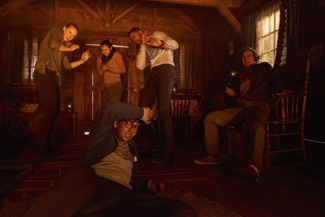|
|
Movie Review: Escape RoomBy Ben GruchowJanuary 16, 2019
This is one of the movie’s two main strengths: it ladles in clues and shades of character development mostly in small chunks, against a plot that moves at a steady pace that’s still brisk enough to avoid any passages of momentum-deadening stasis or exposition—up to a point. There’s a no-frills sensibility to each of these minor revelations that acts as a kind of emotional cushioning. I am thinking of an exchange involving a winter coat for warmth, where the participants accept and act without fanfare; the story being in constant motion, we have little choice but to do the same along with them in order to keep up. These things help us develop some kind of attachment to otherwise thinly-drawn characters; it’s a far shorter distance to root for them than against them, or to simply watch them being manipulated through a setpiece. Those setpieces are Escape Room other, more obvious strength. There are a half-dozen escape-room scenario, give or take one that seems like a quick transitional piece more than anything else, and each one is an impressive achievement in set design and puzzle construction. The showcase sequence (and the film’s absolute pinnacle in terms of tension and visual ingenuity) puts the remaining characters through an upside-down country-western bar set, with the inversion of an utterly typical environment making us do some unexpected heavy lifting cognitively in order to make visual sense of what’s going on. This is also where the movie’s logic starts to break down even on its own fantastical terms (although the sequence is so involving that we either don’t notice or don’t care). When the bar set reveals the nature of its stakes, it raises the question in our minds of spatial orientation relative to the building we saw the characters enter; the reveal doesn’t break that sense of relativity, technically, but it does redesign the layout of Minos in our minds in a way that begs further detail and exploration, and that point never arrives. We simply move on to the next room. More consequential is what this reveal does to the story’s foundation; it basically lays the groundwork for a very specific type of resolution, and the resolution we actually get is the point I referred to a few paragraphs ago. Put simply, the final set of plot reveals don’t just break the movie; they break each other and themselves in real-time. And the effect is cumulative, so each new break is more resonant than the previous one. There is a variant on the Talking Killer, with motives that cheapen the elaborate trials of the last hour; there is a variant on It Was All a Dream, which answers an early question about an odd name and lands a decent punch while also removing much of the investment we might have had; there is the very last scene, which utterly annihilates the previous scope of influence for the antagonist(s) and begs the question of why they (or we) bothered with the main narrative at all. And yet I find it tough to get very worked-up about this late collapse in logic. This has to be partly due to lowered expectations; I certainly wasn’t planning on a PG-13 thriller in January to hit a home run in narrative or resolution in any capacity. It’s partly due to the fact that the rest of Escape Room really is decent. Director Adam Robitel keeps the tone and psychology just this side of plausible; the cast reaches for the believable corners of the characters they’re playing. The basic pitch is functionally delivered, and the movie works, as advertised. It’s the underlying context that ultimately lets it down, if only just. 2.5 out of 5
|

|
|
|

|
Thursday, October 31, 2024
© 2024 Box Office Prophets, a division of One Of Us, Inc.


